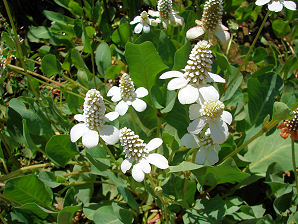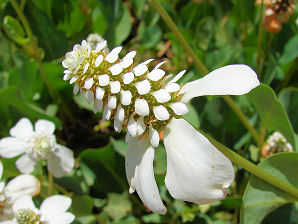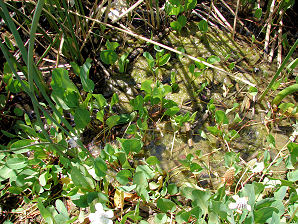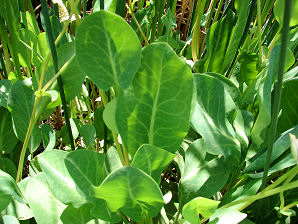Arizona Wild Flowers
Pictures, Photos, Images
Descriptions, Information, Reviews.
Yerba Mansa, Anemopsis californica.
We Are Proud Of Our SafeSurf Rating!
Click On Any Of The Following Links By Amazon.Com
For Books, & Videos About Wildflowers Of Arizona & The Southwest USA. No Obligation!
 |
| Yerba Mansa, Anemopsis californica. |
|---|
 |  |
| Yerba Mansa, Anemopsis californica. | Yerba Mansa, Anemopsis californica. |
|---|---|
 |  |
| Yerba Mansa Flower. | Yerba Mansa. Runners Into The Water. |
 |  |
| Yerba Mansa Leaves. | Yerba Mansa Leaf. |
Yerba Mansa.
We wish to thank Wikipedia, the free encyclopedia for some of the information on this page. We share images and information with Wikipedia. Thanks to the alert observations of Bryan Lewis and Howard McBride, we were led to a beautiful outgrowth of this wonderful Arizona Native Plant. Yerba Mansa grows in the alkaline wetlands of Arizona, New Mexico, and California. Its family, the Saururaceae, has only one other member Saururus cernuus or "Lizard's Tail" which grows in the Eastern and Midwestern wetlands of the United States. So, if you want to find this plant a riparian area or a cienega would be the best place to look. Anemopsis californica produces long runners bearing new leaves and roots. A single plant can quickly spread to form a fragrant, leafy carpet. It's leaves are mostly in a radical cluster at the base of the stem; they are from 2 to 4 inches in length, one-half as broad, of a firm, leathery texture, smooth and entire; their outline is oblong, with a cordate base. The leaf-stalks are about the length of the leaf, dilated at the base, and pubescent along the margin. Its smell is a spicy fragrance resembling eucalyptus, juniper, and wild ginger. Native Americans used the leaves for herbal tea. It was named for the local Indians. They called it �Yerba del mansa,� which means �herb of the tamed Indians.� Thus its name.
Quick Notes:
Height: Up To About 18 inches tall.
Flowers: The "flower" is actually a conical one inch cluster of very tiny yellow stamens and pistils hidden among bright white petal-like bracts or modified leaves.
Flowering Time: May - June.
Leaves: It's leaves are mostly in a radical cluster at the base of the stem; they are from 2 to 4 inches in length, one-half as broad, of a firm, leathery texture, smooth and entire; their outline is oblong, with a cordate base.
Found: Native to the USA (AZ, CA, CO, KS, NE, NM, NV, OK, OR, TX, UT). Also found in northern Sonora, & Baja California, in Mexico.
Hardiness:
Soil pH requirements:
Sun Exposure:
Elevation: 800 - 4,800 Feet.
Habitat: Usually riparian areas but it prefers salty, brackish, or alkaline environments such as a cienega. If you try to grow it in Arizona, it requires consistently moist soil; do not let dry out between waterings. It is more suitable for bogs and water gardens.
Miscellaneous: Flowering Photos Taken May 18, 2006 In Gilbert, Arizona, in a riparian preserve.
|
We Are Proud Of Our SafeSurf Rating!
Click On Any Of The Following Links By Amazon.Com
For Books, & Videos About Wildflowers Of Arizona & The Southwest USA. No Obligation!
| © 1966 - Present, Audrey, Eve, & George DeLange |